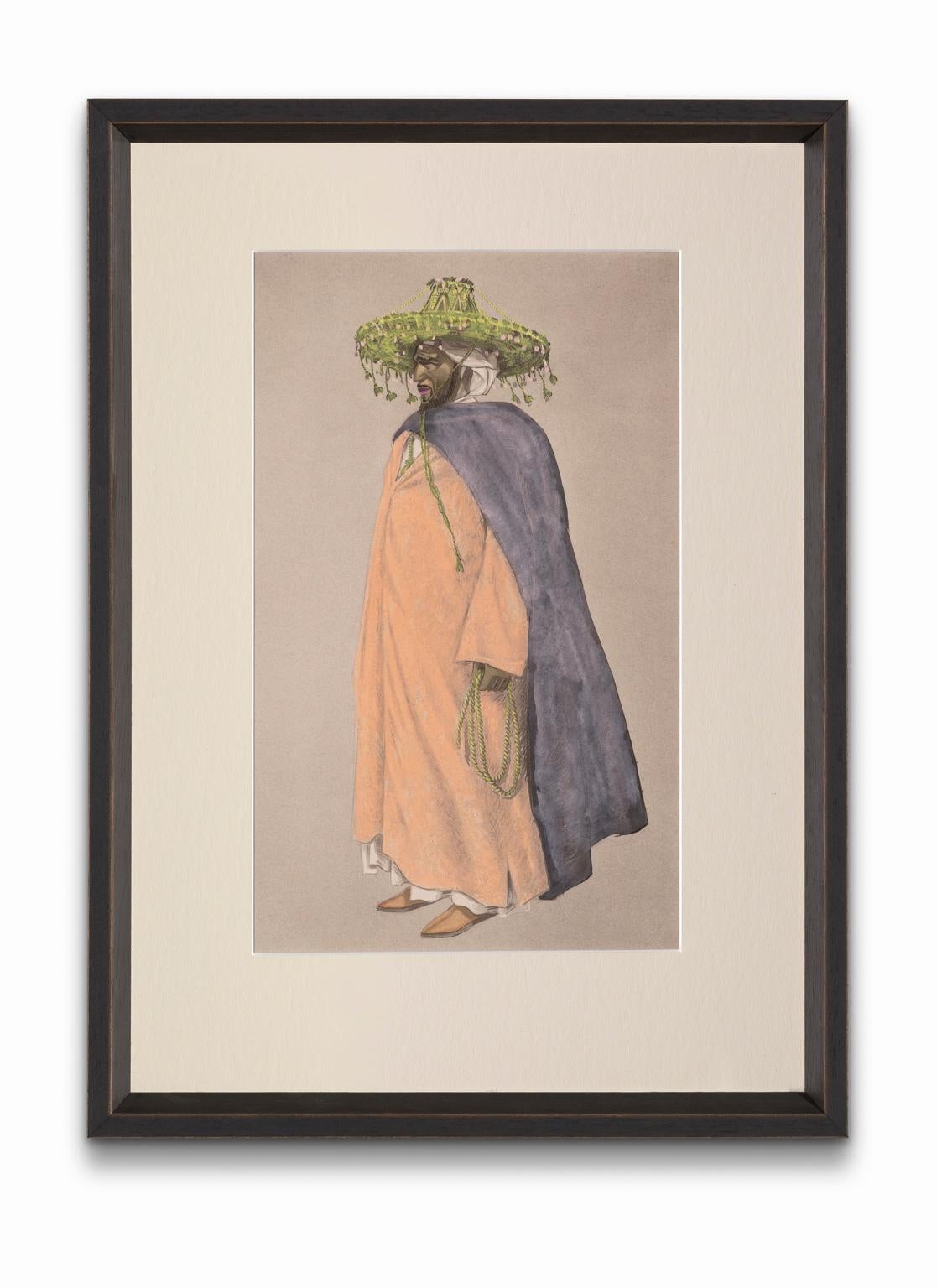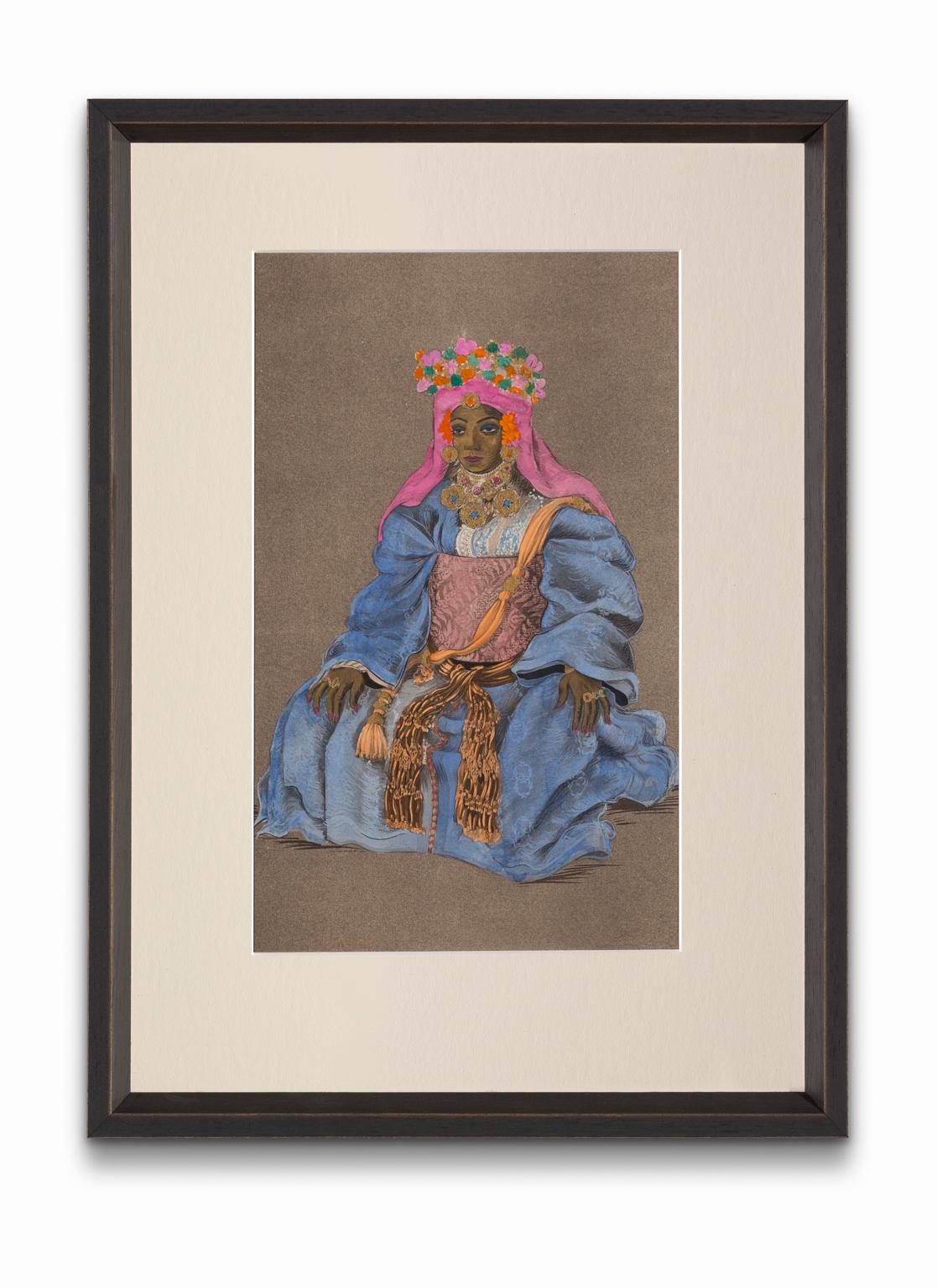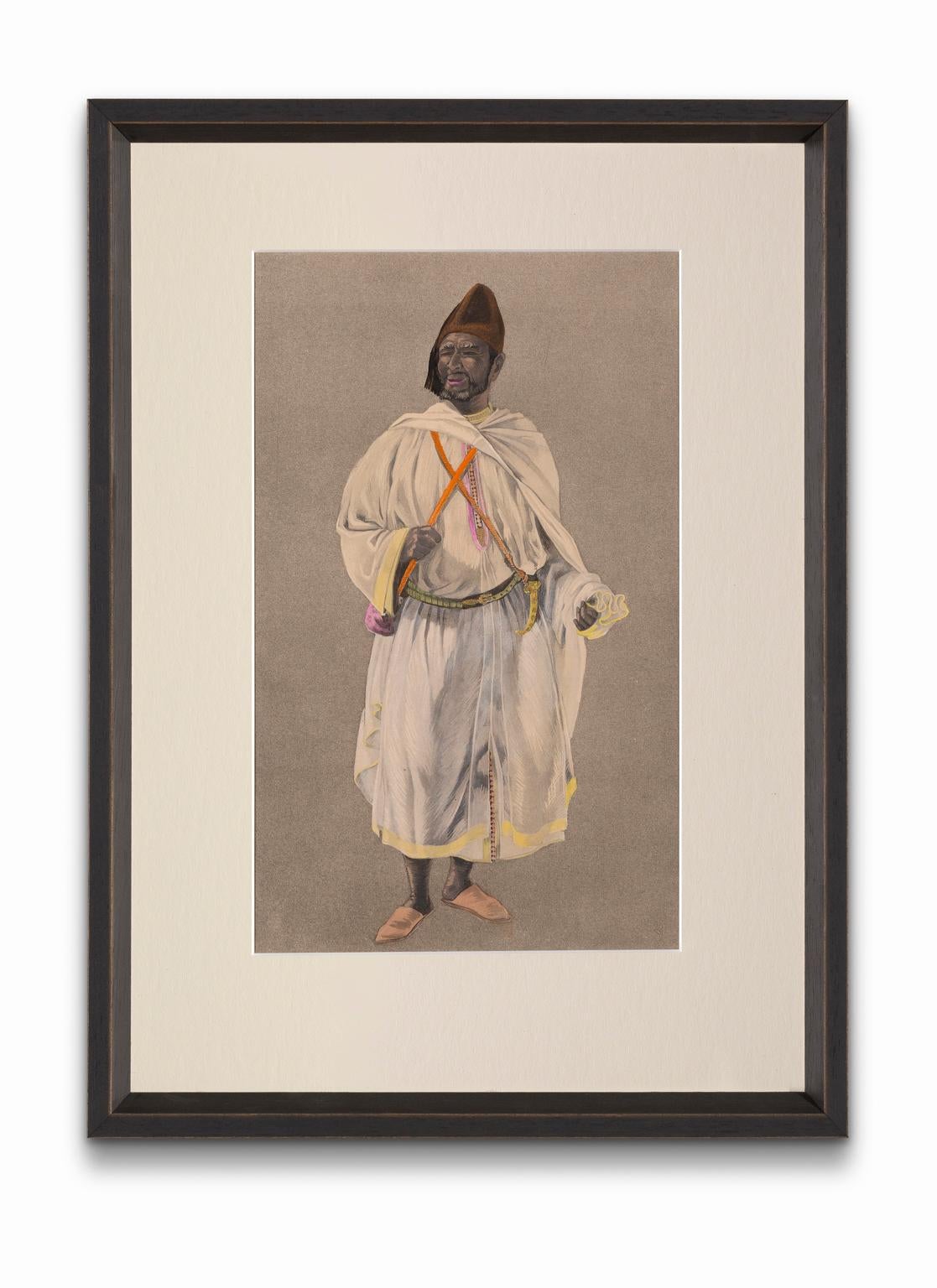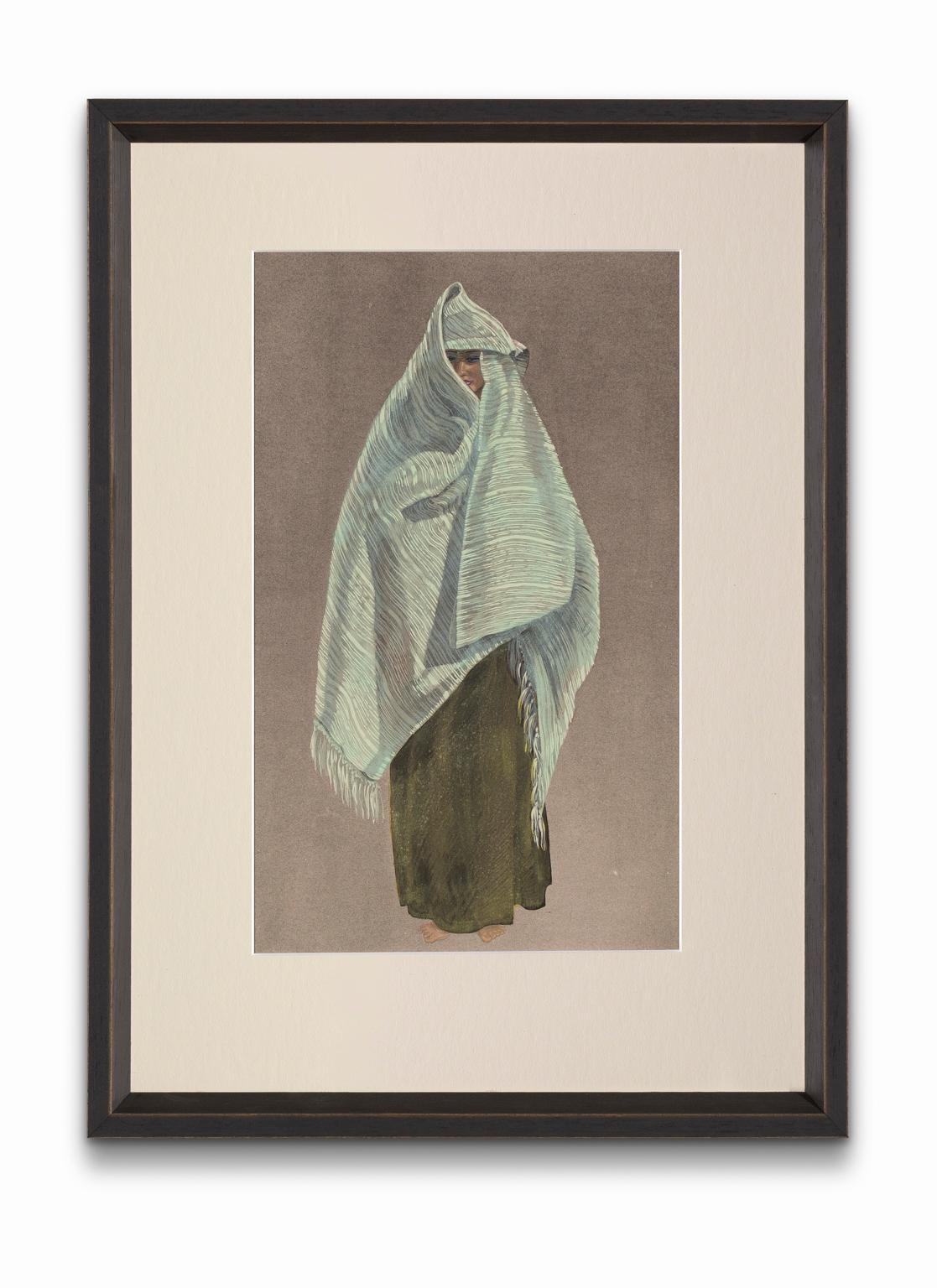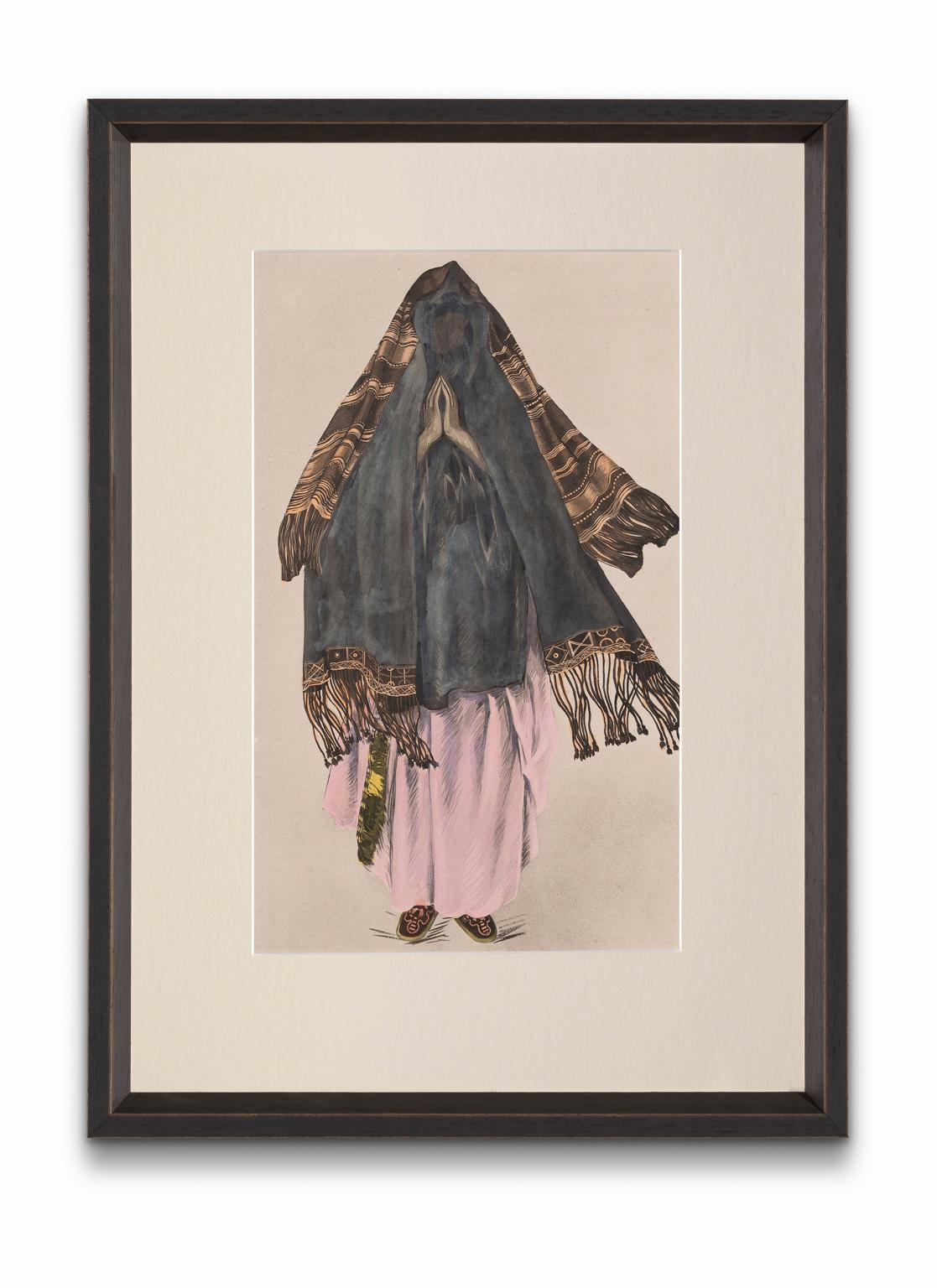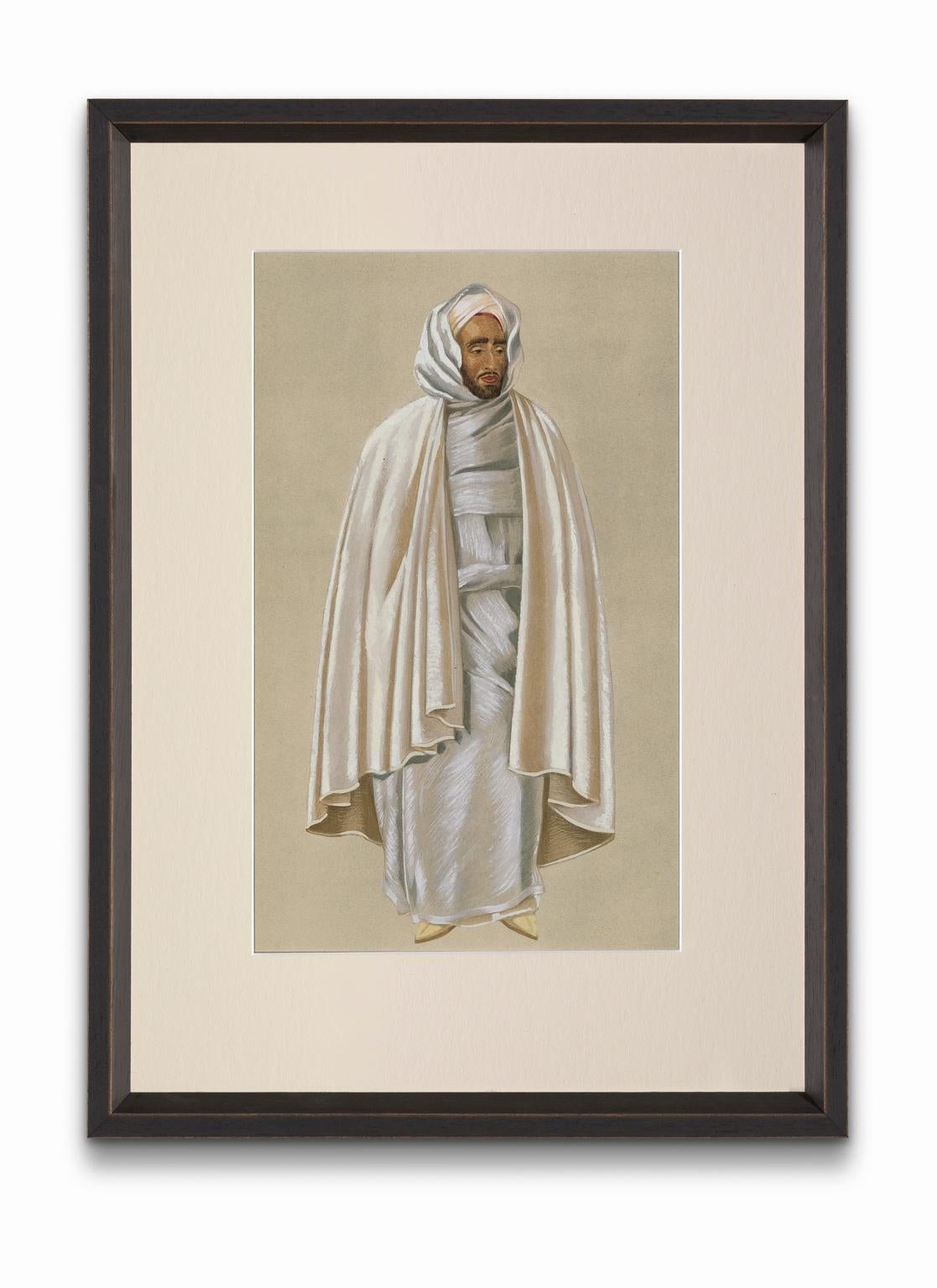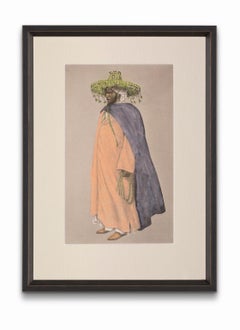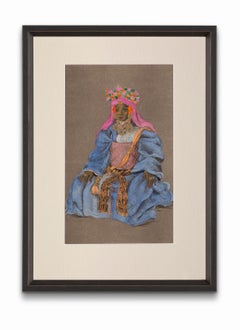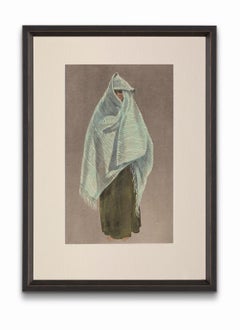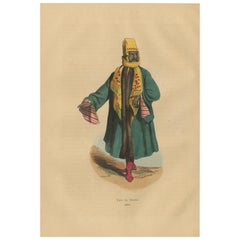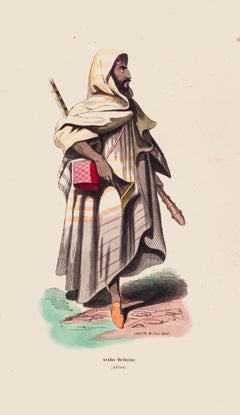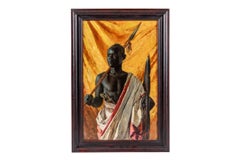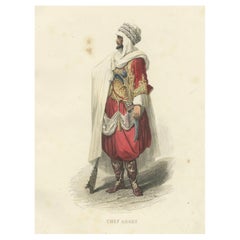Items Similar to "Man of The Ouanergui Carrying the Tabbane" from "Costumes of Morocco"
Want more images or videos?
Request additional images or videos from the seller
1 of 10
Jean Besancenot"Man of The Ouanergui Carrying the Tabbane" from "Costumes of Morocco"1942
1942
$1,800
£1,376.21
€1,576.78
CA$2,538.91
A$2,764.23
CHF 1,476.01
MX$33,368.57
NOK 18,556.08
SEK 17,259.32
DKK 11,777.76
About the Item
"Homme de L'Ouanergui Portant le Tabban" translated to "Man of The Ouanergui Carrying the Tabbane" is plate number 25 in Jean Besancenot's stunning portraits and depictions of the people of Morocco from his series "Costumes du Maroc" ("Costumes of Morocco). The man depicted here is wearing a hunter's outfit which includes the "tabban", what Besancenot described as "a kind of long thick pair of drawers knitted in natural wool and striped brown and white" and "worn in particular by hunters" who required warm clothing to handle cold climate of the mountainous terrain. The man is from the mountain tribes of Central Morocco, from the Ouanergui mountainous region.
Jean Besancenot's sixty plate reproduced and handcolored gouache on paper study on the diversity of Morocco's cultures is a work of stunning historical importance in tracing the rich and vibrant diversity of North Africa. Besancenot spent the 1930s traveling around Morocco, undertaking an awe-inspiring study of its peoples and rendered in vivid and precise detail the way they traditionally lived and dressed. Many of those outfits and cultural expressions are gone now, with Besancenot's watercolored drawings of them some of the only ways that people can now visit the past. The original manuscript of "Costumes du Maroc" is kept in the Royal Collection in Rabat, with only 310 copies of it produced. These prints are fresh from the folio and have been newly museum framed under conservator glass; unframed the image of the print is 12.75 x 7.75 inches. The tissue guards that bear the caption of the plate have been framed in the verso with the title visible behind clear plastic.
Jean Besancenot, real name Jean Girard, was a photographer, painter, designer, and ethnologist who was born in 1902 in Estrées-Saint-Denis. His work straddles the crossroads of art and ethnography as he was primarily interested in the costumes and ornaments of Morocco in the first half of the 20th century. He arrived for the first time in Morocco in 1934, a country he traveled through until 1939. There he produced a very rich ethnographic documentation on the traditional costumes and adornments of the different Moroccan ethnic groups. His work, composed of photographs, films, drawings and paintings, testifies to the aestheticism of Moroccan cultural heritage that was still marked by little Western influence.
His book "Costumes du Maroc" was published in 1942 at the end of his first trip and presents 60 documented plates of Moroccan costumes and their meanings in local customs. In 1947, Jean Besancenot became the iconographic manager of the Protectorate of France in Morocco where he was responsible for carrying out a documentation mission on Moroccan folklore and crafts. Besancenot encountered many difficulties in carrying out his work, some of the Moroccan Muslims being hostile to the representation of the human figure. As he was met with suspicion and superstition, with doors being frequently closed to all strangers and women rarely coming out with their faces uncovered, he had to work with photographic snapshots and wait a long time at the doors of homes and businesses to catch glimpses of the people. The work required five years of research and direct contact with the population. Besancenot chose 60 outfits that best characterize, according to him, the folklore of the Moroccan populations.
He subsequently became a collaborator at the Musée de l'Homme in Paris. His work was particularly honored at the Maison de la photographie de Marrakech in 2018. He died in 1992 in Bry-sur-Marne.
Photography by PD Rearick
About the Seller
5.0
Vetted Professional Seller
Every seller passes strict standards for authenticity and reliability
Established in 2014
1stDibs seller since 2019
110 sales on 1stDibs
Typical response time: 12 hours
- ShippingRetrieving quote...Shipping from: Detroit, MI
- Return Policy
More From This Seller
View All"Man of the Zemmour" from "Costumes of Morocco", Gouache on Paper
Located in Detroit, MI
"Homme des Zemmour" translated to "Man of the Zemmour" is plate number 24 in Jean Besancenot's stunning portraits and depictions of the people of Moroc...
Category
1940s Portrait Prints
Materials
Paper, Gouache
"Formal Dress Called <Of The Maghzen>", from "Costumes of Morocco"
Located in Detroit, MI
"Costume du D'Apparat dit du Maghzen" translated to "Formal Dress Called " is plate number 14 in Jean Besancenot's stunning portraits and depictions of...
Category
1940s Portrait Prints
Materials
Paper, Gouache
"The Sultan's Moghazni" from "Costumes of Morocco", Gouache on Paper
Located in Detroit, MI
"Moghanzi du Sultan" translated to "The Sultan's Moghazni" is plate number 4 in Jean Besancenot's stunning portraits and depictions of the people of Mo...
Category
1940s Portrait Prints
Materials
Paper, Gouache
"Woman of Tiznit Wearing the Amendil", from "Costumes of Morocco"
Located in Detroit, MI
"Femme de Tiznit Portant L'Amendil" translated to "Woman of Tiznit Wearing the Amendil" is plate number 47 in Jean Besancenot's stunning portraits and ...
Category
1940s Portrait Prints
Materials
Paper, Gouache
"Woman Of Tagmout (Singing the Ahwash)" from "Costumes of Morocco"
Located in Detroit, MI
"Femme de Tagmout Chantant L'Ahwas" translated to "Woman Of Tagmout (Singing the Ahwash)" is plate number 44 in Jean Besancenot's stunning portraits and depictions of the people of Morocco from his series "Costumes du Maroc" ("Costumes of Morocco). The woman depicted here is veiled and draped and in the midst of singing the "ahwash", a traditional song and dance from the regions of southern Morocco, such as Tagmout, and which has some roots in the pre-Islamic cultures of the Amazigh (also known as the Berbers) and is performed primarily by the Shilha, a sub-group of the Berbers. The ahwash is a community performance that incorporates song, dance, poetry, and frame drums...
Category
1940s Portrait Prints
Materials
Paper, Gouache
"City Notable" from "Costumes of Morocco", Gouache on Paper
Located in Detroit, MI
"Notable Citadine" translated to "City Notable" is plate number 2 in Jean Besancenot's stunning portraits and depictions of the people of Morocco from ...
Category
1940s Portrait Prints
Materials
Paper, Gouache
You May Also Like
Traditional Attire of a Man from Mardin in Turkey in 19th Century Lithograph
Located in Langweer, NL
Title: "Traditional Attire of a Man from Mardin in 19th Century Lithograph"
This lithograph, titled "Turc de Mardin," features a man from Mardin, a city in what is now Turkey. The i...
Category
Antique 1840s Prints
Materials
Paper
$133 Sale Price
20% Off
Arab Man - Original Lithograph by Lacoste Jean Luis - 1854
Located in Roma, IT
Arabic is an original modern artwork realized in 1854 by Lacoste Jean Luis.
Original Hand-colored lithograph on paper.
Plate signed on the lower, titled lowe...
Category
1850s Modern Figurative Prints
Materials
Lithograph
A Rare Orientalist Portrait of a Nubian Guard, by Edmund Walenta, 19th Century
Located in Queens, NY
A Rare Orientalist Portrait of a Nubian Guard, by Edmund Walenta, 19th Century.
Oil on canvas.
Extremely high quality and attractive orientalist painting by American / German artist Edmund Walenta. In the style of Ludwig Deutsch...
Category
19th Century Portrait Paintings
Materials
Canvas, Oil
Arab Chief Costume Print Algeria 1853 by Compte-Calix – Hand-Colored Lithograph
Located in Langweer, NL
Arab Chief Costume Print Algeria 1853 by Compte-Calix – Hand-Colored Lithograph
This fine antique print depicts a dignified Arab Chief (Chef Arabe) from Algeria, captured in detaile...
Category
Antique Mid-19th Century French Prints
Materials
Paper
Man from Puebla - Original Lithograph - 1849
Located in Roma, IT
Man from Puebla is an original hand-watercolored lithograph on ivory paper by Anonymous Artist of 19th Century, in 1849.
In excellent conditions: As good as new.
Not signed. Title...
Category
1840s Modern Figurative Prints
Materials
Paper, Lithograph
Algerian Man - Lithograph - 19th Century
Located in Roma, IT
Algerian Man is an original hand-colored lithograph on paper realized by an Anonymous artist of the XIX century, it represents a standing algerian in his traditional costume with tur...
Category
19th Century Modern Figurative Drawings and Watercolors
Materials
Lithograph
More Ways To Browse
2018 Dior
Moroccan Plate
Cape Town Paintings
Cheetah Oil Painting
Crop Circles
Dali Desert
Erte Poster
Female Art Deco Nude Corne Akkers
George Burns
Goodall Frederick
Grant Wood Paintings
H Meyer
Hand Tinted Photograph
Horse Pencil Sketches
Industrial Art Photos
Jack Russell Terrier Oil Painting
Jack Wilson
James Douglas
